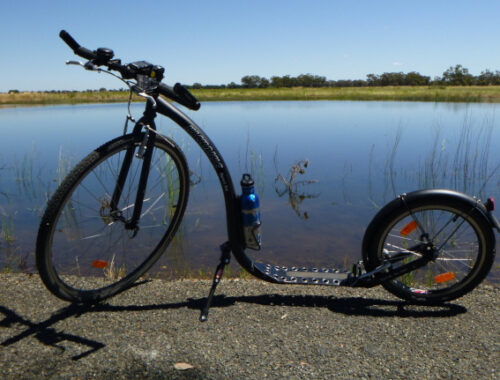Me, Pa and the Car
When my dad (who the kids call Pa) visits, I normally take that opportunity to do some sight-seeing. Often the sight-seeing includes trying to discover interesting railway related stuff (we are both quite interested in trains) where we are travelling.
So we filled the car up with fuel, and headed east. The plan was to explore Tumbarumba first, then travel through Batlow, Tumut and Gundagai, in New South Wales.
At Tumbarumba we found the Mannus Lookout. Rebecca, the kids and myself travelled through Tumarumba about a week ago, but we failed to find the lookout then. Today Dad and I found it! On a map it indicated that the lookout had a 360 degree view. And it would if it wasn’t for all the trees! But I did manage to get this picture of a snow capped mountain away off in the distance.
From Tumbarumba we travelled to Batlow. Batlow is a fruit growing area. Travelling from Tumarumba to Batlow we passed a number of orchards. The town itself is nestled into a valley. Very picturesque.
The main street was typical of small towns eveywhere, even down to the lack of traffic.
There were some old abandoned buildings in town, which I think were something to do with the orchards – maybe coolstores, or fruit packing? Seems the most likely. They were serve by the railway, when it was still operating as there were sidings near the buildings.
Then it was on to Tumut. Nestled at the foot of the Snowy Mountains, it was a bustling town, with industries dotted all over the place – there was a factory we saw in the distance at Gilmore, a sawmill at Gilmore, and a sawmill in Tumut. We stopped to have a look at the restored railway station, and the traffic along the road opposite it was fairly constant. Lots of trucks, busses, cars.
Following is a photo of the restored Buttery Factory (from the railway siding side of course), and the restored station.
Then we drove towards Gundagai, the town of bridges. Spanning the Murrumbidgee River flood plain, Gundagai has 3 notable bridges.
Two of them, the old road bridge and the railway bridge, are shown in the photo below.
- The Prince Alfred Bridge, which today has seen better days, was the road bridge across the river at Gundagai. Before the 1970’s it carried all traffic across the river flats. Completed in 1867, it is the oldest still standing bridge of all bridges crossing the Murrumbidgee, Lachlan and Murray rivers. The iron spans of the bridge were of unique design, the top chord was continuous and rested on roller bearings. The piers were made of 6 foot (2 metre) high by 6 foot diameter cast iron drums and were the first large iron castings made in Australia. The Timber viaduct there today was built in 1896 to replace the original bridge and is 921 metres long.
- The next bridge, the railway viaduct, was built in 1903 so the railway could be extended from Gundagai to Tumut. It is the longest timber truss bridge ever built in Australia, at 819 metres length. This bridge is very interesting to look at but really needs some major work, and I wondered whether having the road go under it was really a good idea! I guess those in the know have some idea about whether it’s safe or not.
- The road bridge that effectively bypassed the township, and today carries 4 lanes of traffic across the river flats, was built in 1977. it is called Sheahan Bridge, and is the second longest bridge in New South Wales being 5 metres shorter than the Sydney Harbour Bridge. The bridge is shown in the photo below (the ‘hump’ towards the right hand end is because of the camera, it’s not a ‘feature’ of the bridge).
Byt the time we had looked around the bridges at Gundagai it was 4:30 or so in the afternoon, so it was time to make a dash for home in time for tea.
Henty Field Days
You May Also Like









